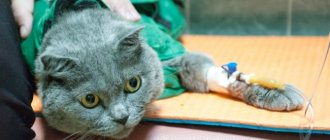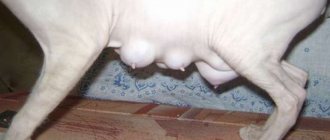Inflammation
A localized purulent inflammation under the skin - an abscess - can be the result of injury or bites. As a rule, it is painful and hot. Abscesses must be treated surgically, otherwise they can break out on their own and spread the infection throughout the body.
Sometimes a lump under the skin can occur as a reaction to the vaccine. In this case, it is painless, its boundaries are unclear. Such a lump on a cat’s skin will resolve on its own after a few months.
Soft bumps in animals
A soft lump on a cat's back is a lipoma. It is quite easy to distinguish it from an abscess and other neoplasms; you just need to grab the lump with two fingers. In this case, the lipoma or wen will easily roll under the skin, and the cat will not feel any discomfort. The formation of wen is caused by the accumulation of sebum. They form a soft capsule that is shaped like a ball.
Lipomas themselves are not dangerous at all and do not cause discomfort to cats. Their appearance is due to endocrine disorders or natural aging of the pet. Nevertheless, veterinarians recommend removing lipomas, as there is a risk of the benign lump degenerating into a malignant neoplasm.
Tumors
If you find a ball under your cat's skin,
this may be a sign of a neoplasm - a benign or malignant tumor (cancer). Any unexplained swelling, bulge, or open wound should be examined by a specialist. In most cases, benign neoplasms are found in cats.
Signs of a benign tumor: growing slowly, surrounded by a capsule, well separated from surrounding tissues. After removal it does not grow back. Wen - benign tumors of adipose tissue (lipomas) - are often found in cats. Unfortunately, lipomas can also be a serious sign of feline leukemia, a systemic cancer.
Malignant tumors are characterized by a high growth rate - the count lasts for weeks or months. They are not surrounded by a capsule and penetrate the surrounding tissues, spreading to regional lymph nodes and further throughout the body. Often such skin tumors are fused to the underlying bone.
Melanomas, growths in the form of moles, are common in cats. Old animals are more likely to develop tumors than young animals. A cat's lump under the skin in the nipple area may be a mammary gland tumor.
A malignant tumor is prone to ulceration and bleeding. You cannot heat any subcutaneous formations, try to remove them yourself, and lubricating them with external agents is useless. Take your cat to the veterinarian - he will determine the type of tumor and prescribe the necessary treatment.
Is it normal for a cat to shed a lot, or is she missing something? Read about it.
Does your pet have a lump on its belly? Then you should immediately contact your veterinarian.
The forecasts are actually not encouraging.
Such formations in 80% of cases mean a tumor. Of course, it could be a bruise or a pellet, but don’t risk the animal’s health. The sooner you seek advice, the longer your pet will live.
Tumors in cats
A tumor on a cat's back can be either benign or malignant. Upon external examination, it is impossible to distinguish one from the other. To make a diagnosis, you should undergo a comprehensive examination by a veterinarian, which includes:
- X-ray of the back.
- MRI.
- Blood analysis.
If cancer is suspected, a biopsy is performed. During this procedure, the lump is pierced with a special needle, into which small fragments of tissue are collected. The resulting material is then sent to the laboratory for histological analysis, which allows the cell type to be determined. After confirmation of the diagnosis, surgical removal of the tumor is performed. For benign tumors, additional drug therapy is not required; for malignant tumors, chemotherapy is performed.
In most cases, tumors and lipomas appear in animals older than 10 years. This is due to the natural aging of the body, a slowdown in metabolic processes and the development of chronic diseases. According to statistics, animals with excess weight and endocrine disorders are more likely to experience lipomas.
Only a veterinarian can accurately determine the type of tumor. The neoplasm will not resolve on its own, so if you notice the appearance of a lump, the animal should be shown to a specialist as soon as possible
The appearance of a lump between a cat’s shoulder blades is not always detected in time, since for a long time they do not bother the pet. This applies to formations of benign and malignant nature, which are characterized by a long course. Harmless causes can go away on their own within a few days; in some cases, when a lump appears, a mandatory examination by a surgeon is necessary to determine the nature and degree of danger of the formation.
WHAT SHOULD YOU PAY ATTENTION TO FIRST?
Quantity
. There may be several or one formation. They may be “scattered” throughout the abdomen. Of course, things are worse if there are many formations. They may bleed or discharge pus.
Structure
should be dense and hard. The smaller its diameter, the better the forecasts.
The tumor can “walk”, that is, move freely when pressed. Pay attention to the period of time
, during which a tumor formed. It can be either short (2 days) or long.
General condition of the animal
(appetite, sleep, activity). There are cases when the cat's condition was active - her sleep and appetite were not disturbed. And there are also cases when favorites faded away before our eyes.
The presence of tumors means cancer. The larger the tumor, the more serious the stage of cancer development. There are four stages of cancer. In stages 1 and 2, the prognosis for recovery is favorable. At 3 and 4 the prognosis worsens.
- the first stage – the presence of a nodule or several nodules;
- second stage – enlarged lymph nodes, inflammation of nearby organs;
- third stage – the tumor metastasizes;
- the fourth stage is intensive growth of the tumor, which covers all nearby organs.
Tests to confirm the diagnosis: X-rays, blood tests, biopsies of lumps and lymph nodes (tissue samples taken directly from malignant tumors or organs), and also an ultrasound.
Video: possible causes of lump formation
Reasons for appearance
The likelihood of bruises or seals is low. Most often, skin or breast cancer is diagnosed.
Breast cancer occurs in 80% of cases
.
This type of cancer affects cats that have not been sterilized
(feeding tablets and drops does not count; sterilization involves surgical removal of the ovaries and tubes).
That is, cats whose hormones are disrupted are predominantly elderly. It usually appears after the cat is seven to eight years old. In 90% of cases the tumors are malignant, in the rest they are benign.
Tumors for breast cancer appear in the lower abdomen, near the ovaries (in the area of the uterus). Dense nodules (tumors) can be located just under the skin, and can also fester and bleed
.
The worst form of “bump” in a cat is armored (visually resembles a shell). The tumor is formed without a capsule (nothing limits it from neighboring tissues) and therefore quickly penetrates into nearby organs. It looks like a large lump with ulcers and pus.
Mammary cancer in cats cannot be completely cured. But there were often cases when cats lived after therapy until their natural death.
For skin cancer
the animal develops
bumps and bleeding ulcers
over the entire surface of the body. They are mainly expressed on the lips, ears, nose and stomach. Pronounced bumps are also located on the pads of the paws. This type of disease can be completely cured.
In any of these cases, you should immediately contact your veterinarian. Detecting cancer at an early stage helps your cat recover quickly.
Treatment of tumors is possible only through surgery
. Chemotherapy is given to completely cure the cancer and prevent the lumps from coming back. No amount of self-medication will help your cat - you will only worsen its condition.
For prevention, you can sterilize your cat during the first year of its life or before the first signs of estrus appear.
Treatment depending on the cause of the appearance of the ball under the skin
To treat a cat and prevent relapse of the disease, the cause is first identified. Only after this are various methods of therapy prescribed. This is the most effective method.
Benign tumors are eliminated using surgery. The tissue is incised, the tumor and capsule are removed, and sutured. If the lump is small, it can be left in the animal’s body, periodically checking for the possibility of its growth.
Lipoma treatment
Lipoma is treated in the same way as a benign tumor. The doctor may remove it if it is interfering with the cat's activities. For example, the presence of a lipoma in the front makes the swallowing reflex and breathing difficult. If it is minor, it is left without damaging the tissue.
The cat moves away quickly after the lump is removed
Abscess treatment
Most often, the abscess is eliminated. To do this, the method of suction using a syringe is used. To eliminate the negative impact on the cat, he is given local anesthesia or general anesthesia.
Important! If the resulting fluid is yellowish or purulent, antibiotics are prescribed, as this is a sign of bacterial inflammation.
Treatment of lymphadenitis
To eliminate lymphadenitis, it is necessary to eliminate the infectious or viral load on the animal’s body. Stimulate his immune system so that it can better cope with infection. Vaccination can be used for this. A small amount of pathogenic microorganisms is injected subcutaneously, which reacts with the immune system.
Treatment of ticks
To prevent ticks, drops, tablets, and injections are used, which destroy the attached tick before it injects poison. If the animal does become infected, medications are used that completely neutralize the toxins. These medications are very harmful to the liver. After this, the animal should be fed food that reduces the load on the liver.
Treatment of scratches
If a scratch appears on the animal’s body, it should be treated with an antiseptic. This could be miramistin, chlorhexidine, hydrogen peroxide, baneocin. This will prevent infection from invading.
If the insect has low toxicity, the animal’s body will cope on its own. But an antihistamine should be given to reduce swelling and inflammation.
Treatment of mastitis
If purulent mastitis appears, broad-spectrum antibiotics are immediately given. If the lump does not resolve on its own, your veterinarian may remove it during surgery.
Treatment of hematoma
If the animal has a hematoma, it is sucked out using a syringe. But if the hematoma is minor, they give the animal the opportunity to recover on its own.
A lump on an animal's body can mean a temporary phenomenon or a serious illness. It can appear in any area of the neck, occupying the right or left side, back or front. This is important for the doctor, since the seal can impair blood circulation and put pressure on the nerves, esophagus, and respiratory tract. In any case, it can be cured if you consult a specialist in time.
If a neoplasm is noticed in an animal, it is necessary to contact a veterinarian. The tumors are removed; no ointments can help with their treatment. If the lump is due to suppuration, it is opened and washed with a disinfectant solution.
When a hernia appears, it is removed with massage or a tight bandage. In extreme cases, surgical removal is resorted to.
Lipoma is rarely removed; in most cases it is treated with ointments and other medications.
Mastitis responds well to treatment with compresses and antibiotics. Sometimes massage is used. For mastitis, a novocaine blockade, physiotherapy, and, in extreme and advanced cases, surgery are also often prescribed.
Cancerous formations are treated with chemotherapy, and then surgery is performed with further removal. It is important to pay attention to whether metastases have occurred, so as not to waste time and take the right treatment tactics.
As for benign formations, if they are small in size and do not bother the animal, surgical intervention is not required. When a soft lump appears on a kitten’s stomach, as a rule, this is a benign neoplasm; conservative treatment methods are most often prescribed.
Benign tumors can be treated with medications
Subcutaneous tumors, such as abscesses and cysts, are treated conservatively, but they cannot be neglected. The specialist washes and treats the area with furatsilin and hydrogen peroxide. In the most difficult cases, additional antibiotics are prescribed. At home, it is better not to squeeze pus out of wounds, as it can enter the bloodstream, and, as a result, blood poisoning or a recurrent abscess will begin. Moreover, there is no need to wait for the abscess to open on its own.
We suggest you read: What medications are best to treat a cat for lichen at home?
Cysts can form due to clogging of the glands, they can be filled with sebum-like contents, and they can be follicular.
For lymphadenitis, the cat is prescribed medications that eliminate inflammation in the lymph nodes.
For infectious bumps, antibiotics and anti-inflammatory drugs are prescribed.
In case of allergies, the cause is determined, antihistamines are prescribed and the factor that provoked the reaction is eliminated.
If a decision has been made to undergo surgery, then after the operation the animal is prescribed a course of antibiotic therapy, immunomodulators, and if we are talking about a malignant tumor, then a course of chemotherapy.
The table shows treatment methods depending on the cause of the tumor.
| Pathology | Basic therapy methods | Possible deviations from general norms |
| Abscess | It is opened and cleaned of pus with antiseptic agents, and a sterile bandage is applied. Antibiotics are prescribed to eliminate the infection. | When treating kittens, gentle medications are selected and the duration of treatment is reduced. |
| Lipoma | Large formations are cut out. | Try not to touch the bumps located on the back near the spine or on the neck unless they tend to increase. |
| Cyst | Small formations are left and their condition is observed. Large growths are cut out. | If parasites are found in the growth, surgery is performed. |
| Hernia | Prolapsed organs are reset. An abdominal massage is prescribed. | A large hernia requires surgery to stitch the diverging ring. |
| Lymphadenitis | The cat is being treated for the disease that caused the pathology. As a rule, antibiotics, anti-inflammatory drugs and painkillers are prescribed. | If all lymph nodes become swollen, the development of leukemia or leukosarcoma is suspected. |
| Mastitis | The swollen organ is anesthetized with Novocaine, physiotherapy is performed, and compresses are made with anti-inflammatory drugs. | The disease in its advanced form is eliminated surgically. |
| Cancer | At the initial stage, chemotherapy or radiation is performed. The tumor is excised. | In later stages, pain is controlled and euthanasia is recommended. |
| Eosinophilic granuloma | Treatment is prescribed depending on the cause of the pathology. Steroids, antibiotics, and antiallergic drugs are prescribed. | When a large, weeping wound forms, surgical removal of the cosmetic defect is required. |
| Inflammation of the paraanal glands | Squeeze out the fluid accumulated in the glands. | If the cat experiences severe discomfort, Novocain is administered. |
WHAT TO DO IF THE BUNE IS UNDER THE SKIN?
If your cat has a lump under the skin, the first thing you need to do is determine its structure. Eliminate pellets, skin formations from old age (something like a small hanging drop from the skin layer). Look for ticks
- they often crawl under the skin, forming a small tubercle.
A dense nodule indicates that the cat has a tumor. And it, in turn, is the result of cancer. There may be several nodules or one, but fast-growing.
You should contact your veterinarian immediately. Don't do anything yourself. No ointments will help. This requires surgery.
Diagnostic methods
If you notice a lump or lump on your pet's body, you should immediately contact your veterinarian.
To make a correct diagnosis, the doctor will need some information: how long ago the lump appeared, whether it is growing rapidly, whether it affected the mood and condition of the pet, how many such lumps are on the body.
After receiving this information, the veterinarian will conduct a thorough examination of the cat's body and take the necessary tests, such as biopsy and cytology.
Then, when the test results are ready, the doctor will prescribe the necessary treatment for your cat. The content of therapy depends on the nature of the lump, so for each individual case the treatment will be different.
Remember that it is highly undesirable to treat your pet at home without consulting a veterinarian. This may not work or may be fatal.
We suggest you read: How to clean the soil in an aquarium - Questions
WHAT TO DO IF THE BUNE IS WITH PUS?
Do not squeeze or pierce under any circumstances! Not only will you torture the animal, but you can also hurt internal organs. Which will lead to the approach of death.
Purulent lump
– means cancer in the final stages of development.
The cat will slowly fade away. You won't help her in any way. Contact your veterinarian
.
Video: possible cause – tumor
Animals can get sick just like people. It is especially necessary to take care of pets that live with a person in the same house. If you have a domestic cat, then you should be especially interested in its health, since these cats are prone to frequent colds and allergic reactions. And due to its certain body functions, a cat is susceptible to diseases that most often prevail among these representatives of the animal world.
Skin diseases are also no exception. Cats of different breeds can tolerate climatic conditions differently. For example, due to prolonged exposure to direct sunlight, cats with light fur or breeds, as well as sensitive Sphynx cats, are prone to sunburn.
What could it be?
A lump between a cat's shoulder blades may be a common insect bite or a formation, the nature of which cannot be determined without a fine-needle biopsy and histological examination. Much attention is paid to the general condition of the animal, age and events preceding the appearance of the seal. You can only identify insect bites by eye; everything else requires qualified diagnosis using cytological and histological examination. Most often, the reason lies in the following pathologies:
- Hematoma. It can form after a strong blow during an accident or a fall from a great height. If a lump between the shoulder blades of a cat appears after a recent injury, then you need to consider the option of a hematoma. Small hematomas resolve on their own within a few days. Only after serious accidents may surgical intervention be required, during which the contents of the hematoma are pumped out with a syringe or an incision is made and the wound is completely cleaned out. Afterwards antiseptic treatment is carried out. Compresses with levomekol may be required. Healing takes from 5 to 10 days.
- Abscess. It can form for several reasons at once, ranging from a foreign body getting under the skin to a recent vaccination. If a cat develops a small bump between the shoulder blades after vaccination, this is considered a normal reaction. In most cases, it resolves on its own within 3-7 days. If pus and severe redness are present, this indicates the development of an inflammatory process. In some cases, abscesses form after wood chips, claw remains and other objects get under the skin, which can cause suppuration. Sometimes they burst on their own when ripe, then it is necessary to carry out thorough antiseptic treatment of the wound. But, there are times when abscesses have to be opened, as they cause excruciating pain to the pet, reaching significant sizes. This procedure is carried out in a hospital setting, as there is a risk of secondary infection. It is also necessary, if possible, to pump out all the pus from the cavity and drain the wound. After this, compresses based on anti-inflammatory ointments are prescribed, which are applied to the wound in the morning and evening until complete recovery.
- Insect bites. A lump between a cat's shoulder blades may be the result of a bite from fleas, flies, ants, gadflies, ticks, wasps or bees. If an animal has been bitten by a tick, it should be removed without damaging the head, as it may remain in the wound and fester. For this purpose, special gripping forceps are used, which are sold in every veterinary store. After removal, you should make sure that nothing is left in the wound, then treat it with miramistine or chlorhexidine. In the coming days, you should carefully monitor the pet’s general condition (weakness, refusal to eat, lack of coordination, seizures) and promptly take it to the veterinarian if any alarming symptoms appear. Fleas can be easily gotten rid of with the help of modern antiparasitic drugs Stronghold or Frontline, which are applied to the animal’s withers monthly. This applies to all cats, even those who never leave their homes. Parasites can get onto a pet's fur from the soles of the owner's shoes or from his clothes. Seals after bites of gadflies and flies go away on their own within a few days. Things are a little more complicated with bumps after wasp and bee stings, since along with redness there is almost always severe swelling. But, a distinctive feature of such edema is that it quickly disappears even without the use of any medications.
- Neoplasms. You shouldn’t forget about them either. A hard lump between a cat's shoulder blades could be a lipoma, fibroma, or malignancy (lymphoma or sarcoma). When making a diagnosis, the age and general condition of the animal are of great importance. In pets over the age of 12 years, the risk of developing malignant tumors is much higher than in younger animals. The nature of the origin of the compaction can only be determined using a fine-needle biopsy and histological examination. Based on the data obtained, effective treatment is selected.
Remember, not every seal between a cat’s shoulder blades can be dangerous to its health, but it’s never a bad idea to see a veterinarian with such a symptom.
The appearance of subcutaneous lumps on the body of a pet is an alarming sign that requires mandatory diagnosis. The wide variety of possible causes precludes any attempt at self-treatment. An incorrectly selected technique can harm the pet and worsen its well-being.
Despite the danger of possible consequences, do not panic. Many neoplasms are benign. For an accurate result, a thorough examination at a veterinary clinic will be required.
Abscess as a manifestation of tumor formations
To understand in more detail, you should know the main diseases that can contribute to the formation of swelling on the back. Most often, a disease such as an abscess can develop. It manifests itself as an accumulation of pus in the subcutaneous layer, especially at the site of a bite or puncture wound.
Over time, this can lead to rupture and the release of copious amounts of pus. In this case, you should consult a veterinarian. To avoid such troubles in the future, it is better to keep your cat indoors.
Other skin diseases in cats
A lump on a cat’s body can also indicate a formation such as a wen. This is a common occurrence in both. But it is worth noting that if a wen is detected, it is recommended to consult a veterinarian. Such an unpleasant manifestation is usually a rather soft and mobile formation under the skin, and it can appear anywhere.
When pressing on the wen, the cat does not feel anything, since this formation is absolutely painless. However, the wen should be removed as quickly as possible, otherwise over time it may grow for the worse.
Another unpleasant moment may arise if you see a pronounced formation. In this way, a lipoma can also appear, which most often occurs in cats infected with the feline leukemia virus. The symptoms of this disease directly depend on the location of the lipoma. The disease must be diagnosed by a veterinarian. Under no circumstances is it recommended to put pressure on the bump in any way, try this place, or, conversely, apply ice. It is possible that this will further worsen the animal's condition.
Neoplasm is a scary word. Fortunately, tumors are not always malignant. But even benign neoplasms can cause many problems. An example is a lipoma in a cat.
Lipomas are benign tumors formed from adipose tissue. They can appear over almost the entire surface of the cat’s body. They are usually soft and located between the skin and the muscle layer. Movable, soft (doughy) to the touch. In some cases, a lipoma can be located between the muscles: then it is as if “stable”, immobile. These tumors are characterized by slow growth, but over time they can reach unrealistic sizes. In many cases, they do not directly threaten the animal’s life, but can greatly interfere with walking and meeting physiological needs.
So, if a cat’s wen has formed between the muscles on the cat’s limb, then very quickly he begins to limp heavily. But that's not the worst thing. In the case where a cat has a wen on the neck, there is a very real possibility of death from suffocation. The danger of lipomas is also that they have a clear tendency towards “creeping progression”. Simply put, these tumors spread rather quickly over the surface of the body.
These neoplasms are divided into simple (non-infiltrative) and infiltrative. Simple lipomas have clear boundaries, are mobile, and are easy to remove during surgery. The infiltrative type, as the name suggests, tends to penetrate into adjacent muscle tissue, becoming deeply rooted there. Fortunately, they do not give metastases. Alas, sometimes lipomas (there are many such cases) can degenerate into liposarcoma. These are already malignant tumors, they give a lot of metastases. In addition, from a “cosmetic” point of view, a lipoma on a cat’s stomach is not the best adornment for a purebred animal.
Types and reasons
The appearance of a lump on a cat’s neck under the skin, abdomen, head or paws may be associated with a malignant or benign neoplasm. The main reasons for the appearance of balls under the skin of a pet are:
- Abscess
. A purulent formation that occurs as a result of a pet being bitten by another animal. As a result of a specific reaction of the body, leukocytes are sent to the site of damage to further combat pathogenic microflora. As a result, pus is formed, containing dead bacterial microorganisms along with dead leukocytes. An abscess can be large and located in a variety of places on the body. Thus, the appearance of a lump on a cat’s neck caused by an abscess leads to painful sensations in the animal, and there is a significant increase in body temperature in the affected area. Hair loss may also occur at the site of the injury.
- Skin cancer
. Not all malignant skin tumors lead to the appearance of bumps on the cat’s stomach or other parts of the body. But some types of cancer, such as melanoma, sarcoma, sebaceous tumor, mastocytoma or basal cell carcinoma, can cause lumps to appear under the skin. - dermatitis
. A disease that occurs as a result of pet contact with potential allergens - household chemicals, hazardous chemicals or poisonous plants. - Acne
. Having felt a ball under the skin of a cat’s neck, the owner may be very afraid for the health of his pet. But it may just be acne, which is a pimple that forms in the chin and neck area, as well as the tail. The development of pathology is associated with blockage of the sebaceous glands. There are cat breeds that have a genetic predisposition to the disease. - Hematoma
. As a result of damage and injury, a hematoma (subcutaneous hemorrhage) may form under the cat’s skin. Hematomas are most often diagnosed on the hind legs (results of jumping from a height), the head (after fights with other cats). - Injection granuloma
. A lump that appears in the neck area at the injection site may be a granuloma. This pathological change occurs quite often after vaccination of cats. The bumps are capable of self-resorption and go away on their own without medical help a few days after the injection. But in some cases, the lump under the skin may grow and in this case it is important to consult a veterinarian. - Zhirovik
. A lipoma, or in other words a wen, is a benign neoplasm that occurs as a result of pathological changes in adipose tissue. The appearance of lipomas is observed, as a rule, in animals after 7 years of age. - Eosinophilic granuloma
. Damage of an inflammatory nature, more often occurring on the upper lip than on the lower lip and other parts of the muzzle. Eosinophilic granuloma appears as an ulcerative lesion, and the causes are still not clearly defined. - Mastitis
. Lumps on a cat's nipples, which occur more often in cats that have not been sterilized, are called mastitis. The occurrence of mastitis has also been noted in cats during active lactation. The pathology is characterized by an inflammatory process in the mammary glands, leading to discomfort in the animal and an increase in body temperature to high levels. Without the intervention of a veterinary specialist, coping with the disease is quite problematic. - Tumors of the mammary glands
. New growths of the mammary glands look like multiple nodules localized on milk bags, closer to the groin area. Breast cancer is characterized by the appearance of nodular neoplasms on milk bags, hot to the touch, over time acquiring a red tint, and begin to bleed. In addition, purulent exudate may be released from the nipples, which indicates the last stages of cancer.
Clinical picture
Most often, this type of neoplasm is diagnosed in older cats. In general, cats suffer from this disease much less often than dogs, which cannot but please cat lovers. But in these animals, fibrosarcomas (especially post-vaccination ones) are quite common, which in some cases are mistaken for lipomas. So in any case, when a large tumor quickly grows on the surface of the animal’s body, you need to urgently take your pet to the veterinarians, otherwise it may be too late.
The symptoms in all these cases are relatively simple: a slight swelling first appears on the side, back, paw or face. Depending on many factors (age, physical and physiological condition of the cat), this situation can persist for a very long time. But gradually the tumor grows, and in some cases its size can reach truly monstrous proportions. If it is not just a lipoma, but something complexly associated, then the process can take only a few months. The condition of the animal is most often relatively normal, but if the neoplasm reaches a particularly large size, it soon begins to experience visible discomfort.
To immediately understand what exactly you are dealing with, you need to do a biopsy. In recent years, there have been many reports that these tumors are associated with sarcomas and even fibrosarcomas (especially if the lipoma is on the cat's back). In the last two cases, most likely, the chances of recovery are very low.
Causes of subcutaneous lumps
Small round balls often appear after injection under the skin. They are called post-injection granuloma and resolve on their own a few days after the end of the injections. To avoid them, the injection site is massaged daily. Sometimes granulomas remain for life, without changing their size and position. In other cases, the reason lies in:
blockage of the sebaceous glands;
infection of open wounds;
disturbances in the formation or functioning of connective tissues;
inflammatory processes.
The risk group includes older animals, cats with chronic diseases, late castrated and sterilized pets. The risk of developing cancer increases with constant stress, low activity and poor diet. A predisposition also appears with frequent injuries in the same area of the body, infection with leukemia and regular inhalation of tobacco smoke. Cancer is often inherited and is diagnosed in animals older than 7 years.
Diagnosis and preparation for surgery
As we have already said, the biopsy plays the “main violin” here (since any lipoma looks the same). In this case, a piece of tissue is taken from the very depths of the tumor, which is subsequently subjected to cytological examination. In cases where the suspected lipoma is located in hard-to-reach areas, ultrasound and X-ray examinations are also used, which make it possible to determine the prospects for surgical intervention. It is important to understand that this category of tumors (even if they are benign) should be taken seriously and several samples must be taken at once in order to insure against sudden surprises during surgery. Alas, surgery is the only suitable treatment for lipoma. It will not be possible to overcome it by other methods.
Diagnosis of tumors
Any neoplasm requires careful diagnosis to understand the level of danger.
The veterinarian uses:
- clinical examination;
- general blood and urine analysis;
- checking the heart muscle;
- X-ray and ultrasound showing the exact size, location and depth of the tumor;
- endoscopy, which allows you to detect oncology at an early stage;
- biopsy to determine the presence of malignancy.
In such situations, correct diagnosis is very important. The veterinarian will definitely perform an ultrasound on your pet.
- To begin, the veterinarian visually examines the pet and palpates the sore area.
- Then ultrasound and radiography are performed.
- To conduct a thorough cytological and histological examination, it is necessary to take pieces of tumor tissue - a biopsy.
- In addition, blood and urine are collected for additional laboratory testing.
In addition, the veterinarian will refer the animal for blood and urine donation.
- Wen usually does not cause symptoms, but requires professional intervention due to the risk of developing into liposarcoma. This is a malignant tumor and can lead to death for your pet.
- Benign formations also do not manifest themselves in any way.
- Abscesses formed as a result of bites, scratches, and scratching are accompanied by severe itching and possible hyperthermia.
- Allergic reactions, in addition to constant itching, are characterized by possible vomiting due to intoxication.
Surgery and care for a recovering cat
First, a simple incision is made. As a rule, small lipomas are removed without any special frills, and therefore the size of the postoperative wound is small. In cases where the weight of the tumor reaches several kilos (the size of such a “miracle” is visible in the photo), massive drainage has to be done. It is worse when it is necessary to operate on an infiltrative lipoma, since in this case it is also necessary to excise the affected muscles, which significantly increases the postoperative recovery period of the animal. Liposarcomas require aggressive resection of almost all tissues that were in direct contact with the tumor. You should also know that hip lipomas are often associated with the sciatic nerve, and therefore increased caution is required during surgery.
It would seem - such a cautious creature! But in our world no one is immune from illness. One of the most common is a formation, the so-called subcutaneous lumps in cats.
Treatment
Therapeutic measures if a lump under the skin is detected in a cat depends on the nature of the neoplasia, its size and clinical symptoms. Some forms of benign subcutaneous tumors do not require treatment. For example, a hematoma, a post-injection infiltrate uncomplicated by an inflammatory process, or a small lipoma not prone to growth do not require therapy. Large wen, cavernous hemangiomas and sweat gland epitheliomas are usually removed surgically under local anesthesia.
More complex treatment is required for types of subcutaneous tumors such as an abscess or cyst. If you find subcutaneous ulcers in your cat, you should contact a veterinary clinic. There, a specialist will open the abscess cavity, wash out the pus from it, then disinfect the cavity with furatsilin or hydrogen peroxide. If necessary, the procedure can be repeated. To prevent infection, your cat may be prescribed a course of antibiotics.
Attention! Many cat owners believe that a cat’s abscess can simply be squeezed out, and the wound will quickly heal on its own. Veterinarians consider such actions dangerous. There is a high probability of pathological microflora entering an open wound, and incorrect movements when removing exudate can lead to its movement into deeper layers, which is fraught with repeated severe abscess.
Cysts, despite the general name of the tumor, are different:
- Atheromas are small, up to 2.5 cm in diameter, dense cysts filled with sebum-like contents;
- Hairy cysts are formed as a result of blockage of the sebaceous or sweat glands;
- Keratinized cysts are hollow tumors filled with cheesy contents: keratinized epidermal cells and particles of fat;
- Follicular cysts. The most common type of subcutaneous cyst, which is a bubble filled with serous fluid.
Attention! If inside the cyst there is a colony of parasites (alveococcal tapeworms or echinococcus helminths), such a cyst is dangerous for others, including humans.
If the cyst is small, soft, not infectious or parasitic in nature, and does not cause pain or discomfort in the cat, your veterinarian may advise observing it instead of removing it. Very often, small subcutaneous cysts resolve on their own, but if the cyst begins to grow, surgery will be necessary.
Among the methods for removing benign subcutaneous tumors, freezing with liquid nitrogen and destruction with high-frequency currents (electrocautery) are widely used today. Such procedures make it possible to minimize the trauma that is inevitable during surgery.
Malignant subcutaneous tumors at an early stage of development are removed surgically, with excision of nearby tissue. This reduces the likelihood of relapse. After the operation, the animal is prescribed a course of rehabilitation therapy. Chemotherapy and radiation therapy are rarely prescribed to cats.
The appearance of cones in cats is a common phenomenon. Every owner should know that they grow very quickly, and many are even life-threatening. Most of the bumps appear on the animal's tummy. After the initial detection, the owner should not hesitate and quickly consult a doctor, as the animal’s condition may worsen.
Physical examination
If you notice that a kitten has a lump, a neoplasm, or a tumor, it is necessary to examine the kitten for other neoplasms that can appear anywhere - on any part of the body. Just examine the entire skin of the animal with gentle, stroking movements of your hands, trying to detect any other strange growths and neoplasms. Having felt some other “tumor”, make sure that this object is really not provided for by the anatomy. To do this, this area of the body must be examined from the other side and only then draw conclusions. If the lump is present on the other side of the body, then most likely it is just some anatomical detail, but a visual inspection will not be superfluous.
What to do if the lump is bleeding or discharges pus
If the cat owner notices that the tumor has begun to bleed or that pus is oozing from it, then this is a very dangerous symptom that indicates a malignant formation.
Note! Sometimes a cat's lump under the skin on its abdomen can also be an abscess, which can rupture on its own. It is highly undesirable to wait for this, as the pet will experience pain and suffering. Even after septic treatment, pus may still be released for some time, so the wound must be treated and washed.
Very often, cats develop bumps that frighten their owners. The percentage that they are malignant is quite low, so if a neoplasm is detected, you need to take your pet to the doctor’s clinic as quickly as possible for a medical examination and to rule out the worst cases of the disease.
The appearance of subcutaneous lumps on the body of a pet is an alarming sign that requires mandatory diagnosis. The wide variety of possible causes precludes any attempt at self-treatment. An incorrectly selected technique can harm the pet and worsen its well-being.
Despite the danger of possible consequences, do not panic. Many neoplasms are benign. For an accurate result, a thorough examination at a veterinary clinic will be required.
The main causes of bumps
A lump or other growth may indicate cancer. In this case, it is necessary to contact the clinic as soon as possible, because The road gets bigger every minute. The sooner you show your animal to a veterinarian, the higher the likelihood of your pet's recovery. However, lumps or tumors that were found on the body of a cat may indicate other ailments: a cyst, enlarged lymph nodes, hemorrhages, a foreign object or tissue tumor, hernia, abscess.
The pulse in cats is checked from the inside of the hind paw. In a calm state, the pulse should be from 100 to 140 beats per minute. Changes in any direction are a cause for concern.
Whatever your pet’s illness may be - be it tumors on the body or simply suspicious behavior, do not self-medicate under any circumstances - contact your veterinarian and do not delay it!
Prevention recommendations
Prevention alone cannot prevent cancer, but proper adherence to basic recommendations will reduce the likelihood of its occurrence. For the health of your beloved pet it is important:
Check regularly with a veterinarian. After 7 years, the number of preventive examinations increases to twice a year. This helps to diagnose the disease at an early stage and prescribe treatment in a timely manner.
Refuse to purchase hormonal contraceptives. Artificial suppression of sexual desire negatively affects the hormonal background of the animal. Because of this, the body malfunctions and stimulates the development of cancer cells.
Resort to sterilization. Surgery to remove the uterus and ovaries is performed after puberty and minimizes the risk of developing cancer. General anesthesia is more difficult to tolerate at a later age.
Treat against parasites in a timely manner and follow the vaccination schedule. When affected by helminths, ticks or viruses, secondary infections often occur.
Monitor the quality of the diet. Any drop in immunity is fraught with deterioration in well-being.
Follow the rules of care. Keep your skin, ears and eyes clean. Do not let your cat become hypothermic. Owners of hairless breeds are advised to purchase warm clothing for their pets.
Avoid excessive sun exposure. Frequent exposure to direct sunlight is one of the causes of the appearance of malignant tumors.
Monitor for swelling. Regularly push back your cat's fur and check for any questionable lumps.
- Contact your veterinarian if in any doubt. It’s better to be wrong in your assumptions than to miss the moment and lose your furry pet.
Treating cancer is hard work. Due to the constant progression of the disease, it is very important to diagnose it early. If you notice a small lump on your pet’s body that is not accompanied by dangerous symptoms, then do not lose your vigilance - veterinarians recommend undergoing an examination even if all symptoms indicate a benign neoplasm.
The article is for informational purposes only. Contact your veterinarian!











